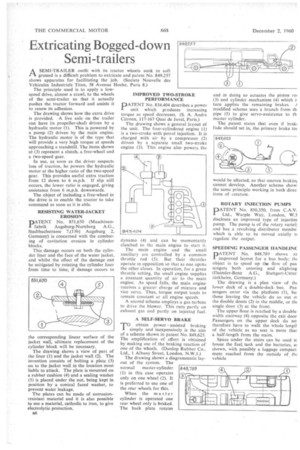Extricating Bogged-down Semi-trailers
Page 80

If you've noticed an error in this article please click here to report it so we can fix it.
ASEMI-TRAILER outfit with its tractor wheels sunk in soft ground is a difficult problem to extricate and patent No. 849,257 shows apparatus for facilitating the job. (Societe Nouvelle des Vehicules IndustrieIs Titan, 38 Avenue Hoche, Paris 8.)
The principle used is to apply a lowspeed drive, almost a crawl, to the wheels of the semi-trailer so that it actually pushes the tractor forward and assists it to renew its adhesion.
The drawing shows how the extra drive is provided. A live axle on the trailer can have its propeller-shaft driven by a hydraulic motor (I). This is powered by a pump (2) driven by the main engine. The hydraulic motor is of the type that will provide a very high torque at speeds approaching a standstill. The items shown at (3) represent a clutch, a free-wheel and a two-speed gear.
In use, as soon as the driver suspects loss of traction, he powers the hydraulic motor at the higher ratio of the two-speed gear. This provides useful extra traction from 12 down to 6 m.p.h. If slip still occurs, the lower ratio is engaged, giving assistance from 6 m.p.h. downwards.
The object of including a free-wheel in the drive is to enable the tractor to take command as soon as it is able.
RESISTING WATER-JACKET EROSION
PATENT No. 851,650 (Maschinenfabrik Augsburg-Nurnberg A.G., Stadtbachstrasse 7,(13b) Augsburg 2, Germany) is concerned with the combating of cavitation erosion in cylinder blocks.
This damage occurs on both the cylinder liner and the face of the water jacket, and whilst the effect of the damage can be mitigated by rotating the cylinder liner from time to time, if damage occurs to the corresponding linear surface of the acket wall, ultimate replacement of the cylinder block will be necessary.
The drawing shows a view of part of the liner (1) and the jacket wall (2). The invention consists of bolting a plate (3) on to the jacket wall in the location most liable to attack. The plate is mounted on a rubber cushion (4) and a sealing washer (5) is placed under the nut, being kept in position by a conical faced washer, to prevent water leakage.
The plates can be made of corrosionresistant material and it is also possible to use a material, cathodic to iron, to give electrolytic protection.
B6 IMPROVED TWO-STROKE PERFORMANCE
PATENT No. 834,404 describes a power I unit which produces increasing torque as speed decreases. (S. A. Andre Citroen, 117-167 Quai de Javel, Paris.)
The drawing shows a general layout of the unit. The four-cylindered engine (1) is a two-stroke with petrol injection. It is charged with air by a compressor (2) driven by a separate small two-stroke engine (3). This engine also powers the dynamo (4) and can be momentarily clutched to the main engine to start it.
The main engine and the small auxiliary are controlled by a common throttle rod (5). But their throttles operate in opposition so that as one opens the other closes. In operation, for a given throttle setting, the small engine supplies a constant quantity of air to the main engine. As speed falls, the main engine receives a greater charge of mixture and vice versa. Thus, torque output tends to remain constant at all engine speeds.
A second scheme employs a gas turbine to drive the blower. This runs partly on exhaust gas and partly on injected fuel.
A SELF-SERVO BRAKE
Pobtain power assisted braking simply and inexpensively is the aim of a scheme shown in patent No. 849,625. The amplification of effort is obtained by making use of. the braking reaction of one of the wheels. (Dunlop Rubber Co., Ltd., 1 Albany Street, London, N.W.1.)
The drawing shows a diagrammatic layout of the system. The normal master-cylinder (1) in this case operates only on one wheel (2). It is preferred to use one of the rear wheels for this.
When the master cylinder is operated one rear wheel only is braked. The back plate rotates
and in doing so actuates the piston rol (3) and cylinder mechanism (4) which ii turn applies the remaining brakes. modified scheme uses a branch from th pipe (5) to give servo-assistance to th master cylinder.
The patent states that even if braki fade should set in, the primary brake to would be affected, so that uneven brakini cannot develop. Another scheme shOw the same principle working in both direc tions of otation.
ROTARY INJECTION PUMPS
PATEN T No. 850,350, from C.A.V. Ltd., Warple Way, London, W.3 discloses an improved type of injectioi pump. The pump is of the rotary varlet: and has a revolving distributor membe which is able to be moved axially t( regulate the output.
SPEEDING PASSENGER IIANDIANC DATENT No. 848,789 shows at
improved layout for a bus body; thi object is to speed up the flow of pas sengers both entering and alighting (Daimler-Benz A.G., Stuttgart-Unter tiirkheinn, Germany.) The drawing is a plan view of tin lower deck of a double-deck bus. Pas sengers enter via the platform (I), bu those leaving the vehicle do so out 01 the double doors (2) in the middle, or th( single door (3) at the front.
The upper floor is reached by a double width stairway (4) opposite the exit door Passengers on the upper deck do no therefore have to walk the whole lengtl of the vehicle as no seat is more thar a half-length from the stairs.
Space under the stairs can be used tc house the fuet tank and the batteries, a! shown, with possibly a luggage compart ment reached from the outside of tin vehicle




















































































































